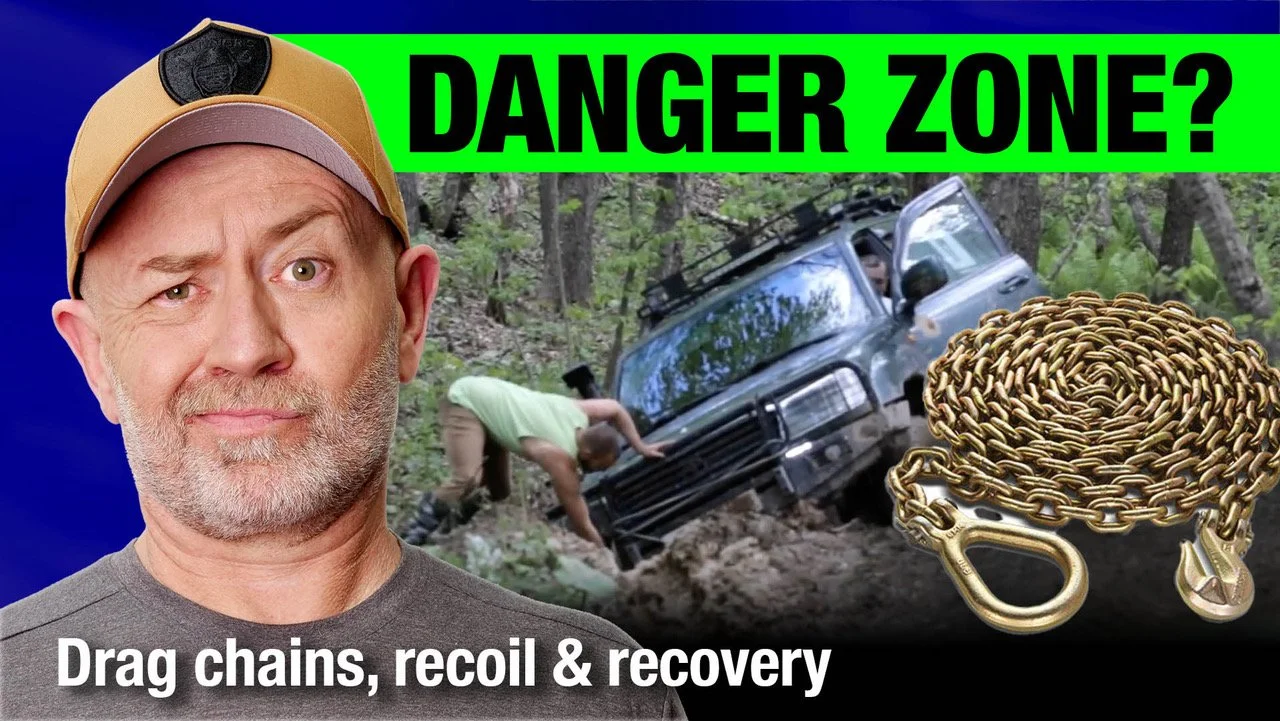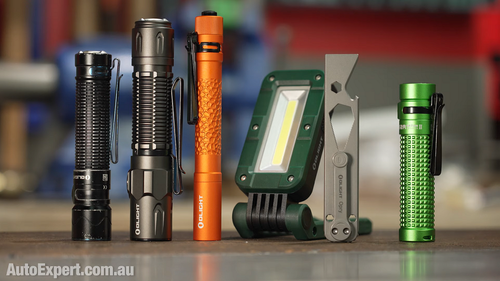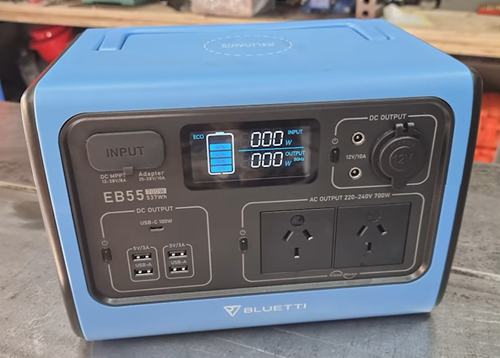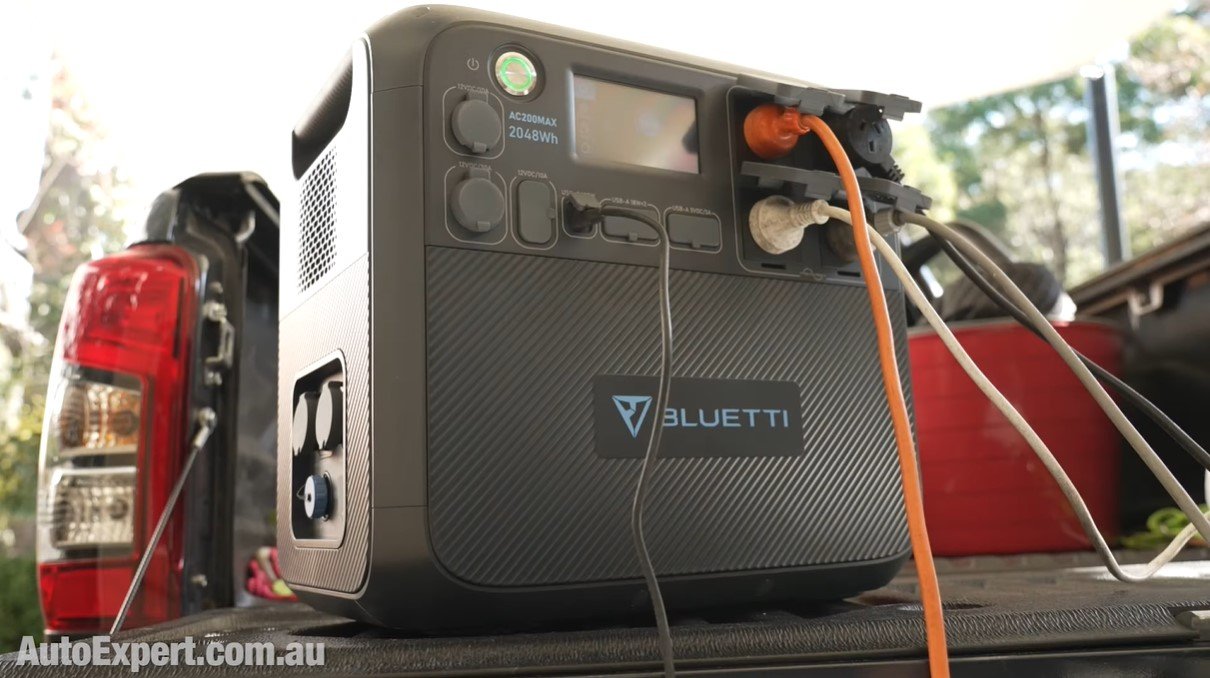How dangerous is drag chain for 4WD recovery?
The beer garden physics you need to know about off-road, high-tensile drag chain. If you use this in four-wheel drive recovery, is it likely to break, recoil and kill someone?
This report is fairly representative of, and in response to, a whole bunch of comments that have been raised in relation to things I've said about four-wheel drive recovery recently.
Namely, the recommendation of using chain instead of the over-hyped and potentially unsafe snatch strap, is what has caused some push-back. So we’ll talk about that, and you can examine some bow shackles, which I have an in-depth soft vs hard shackle report here >> for those interested.
If you’re literally on the road now, heading to your favourite muddy slope, here’s some Basic safe 4WD recovery rules for off-road adventuring >> It’s particularly good for young, inexperienced drivers.
Get some proper off-road driver training before getting yourself knee-deep in disaster.
Anyway, let's unpack everything, because unfortunately, people have died in industry using chains, which is an absolute tragedy but also serves as a good example of why chains need addressing further.
I found two examples from the past couple of decades so we'll discuss why, and how it happened and how it impacts you if you've got one of these babies which you are tempted to use it out there en route to Dingo Piss Creek.
Let’s start with one of the comments which kicked it all off:
The chain might not be stretching very far at all, but that doesn't mean it isn't storing a large amount of energy
- T_Z
What we're talking about here is dragging some stuck four-wheel drive out using a long piece of chain. They typically come set up for four-wheel driving with five meters of chain, so about a car length.
But are you going to stretch it and then is it going to break? And does it have sufficient elastic strain energy to become a projectile that comes back through the glass at you or the poor bastard whom you are rescuing?
There is also at least one slow motion video available on YouTube showing chains breaking under tension. Those don't drop they recoil forcefully back in the direction they were being pulled.
- T_Z
Yeah, there is some recoil, that’s a certainty. And what other direction would they recoil? Because Newton's second law.
And NT worksafe so the work safe mob in the Northern Territory have a fatality on record from a tow chain snapping and recoiling back into the cabin of the tow vehicle in exactly this manner killing the operator.
- T_Z
That is absolutely true, but those circumstances we will unpack because they are very different to four-wheel drive recovery and you'll see why below.
Opinions seem pretty polarized on this chain behaviour and I assume there is a lot of variance in the situations where people have experienced it.
- T_Z
Thing is, opinions don’t really matter to the general understanding about recovery operations using straps and chains and whatever else, because hardly anyone studied physics and yet everyone's got an opinion on this kind of thing far beyond their level of expertise. Isn’t it interesting?
My AutoExpert AFFORDABLE ROADSIDE ASSISTANCE PACKAGE
If you’re sick of paying through the neck for roadside assistance I’ve teamed up with 24/7 to offer AutoExpert readers nationwide roadside assistance from just $69 annually, plus there’s NO JOINING FEE
Full details here >>
AutoExpert DISCOUNT OLIGHT TORCHES
These flashlights are awesome. I carry the Olight Warrior Mini 2 every day - it’s tiny, robust, and super useful in the field or in the workshop. Olight is a terrific supporter of AutoExpert.
Use the code AEJC to get a 12% discount >>
Generators suck! Go off-grid with AutoExpert BLUETTI PORTABLE POWER STATIONS
Need mobile, reliable power? If you’re camping, boating, caravanning or building a dirty big shed in the back paddock, and you need to run a refrigerator, lights, air conditioner, cooking, and/or a bunch of tools - Bluetti has a clean, tidy, robust solution…
Get your AutoExpert free shipping discount here: https://bit.ly/3n62heK
CHAIN IS NOT THE WEAK LINK
This next comment is emblematic of what happens when people sit down and they try to have a decent think about a hard-to-conceptualise issue:
how heavily the chain is loaded as a percentage of its limit, the metallurgy of the chain, what the failure mode was physically, compromised link plastic deformation?
Was it actually the shackle or the tow point that failed etc.?
Seems to me like either behaviour is plausible based on a range of factors, but the easiest way not to have to find out whether your specific chain is going to kill you in your particular use case, is not to use one at all.
- T_Z
Kudos for having a go at the physics of the failure modes of various pieces of recovery equipment. But this kind of comment suggests broadly that they’ve gone looking for evidence online, they found some and have made a wholly erroneous conclusion about just how dangerous a piece of this chain is.
Let’s be abundantly clear here: I'm talking about a specific kind of chain. This is grade 70 drag chain, it's meant in industry for tying loads down on trucks. It's specifically not for lifting overhead. The factor of safety is about 2.something-to-1. So if it breaks, this stuff is going to break at about eight tonnes, and its working load limit is 3.8 tonnes. Also, this is called eight millimetre chain, due to the diameter of the round bar used to make the chain.
You'll see that it's this particular kind of chain because every 12 links there's standards compliance stamping which will be you know reasonably illegible. The purpose of standardising it is, of course, it's all uniform - we know how it's going to behave.
The problem lies with going out in the field and doing four-wheel drive recovery, because, unlike being in a factory and lifting stuff overhead, you don't really know what the loads are that you're imposing on the chain - or your Snatch strap.
What I'm suggesting you do with this chain is you drive gently to the extent of the chain, you take up the slack and then you gently drive away and we use the attractive effort of the mobile vehicle, to assist the recovery of the stranded vehicle. This is not drag racing at Eastern Creek when the lights go green, because that is a really good recipe for breaking something because the chain is not elastic enough to take up much of the shock.
BREAKING POINT
I worked in a testing laboratory for about six months when I was training to be an engineer - I broke lots and lots of stuff. Then, when I was a four-wheel drive journalist, I broke even more stuff in laboratories to write stories on the failure modes of snatch straps and winch extension straps and shackles and chain and so on. It's really interesting.
The shackle is not gonna fail in 4WD recoveries, if used absolutely correctly. And now do I see how you can break the chain in terms of its metallurgy, which is another thing that was mentioned in the feedback questions I received.
Standardised chain is rated from the point of view of its physical performance, because that's what a standard is. In fact, the standard for chain is AS/NZS:4344, and it defines the loaded minimum braking strain wor working load limit etc - the performance - of the chain.
Dimensionally, the performance is standardised, so the metallurgy is standardised, across all 8mm chain or 10mm chain and so forth. The minimum breaking strain, the lashing capacity, working load limit, however it’s described, is also specifically referring to drag chain. It is not that cheap galvanized chain you might buy from Bunnings to wrap around your trailer and the light pole out the front of your house. Not the same thing.
Anything with a standard or a rating on it is designed for high working loads.
So, let’s talk to you about those times when chain has actually killed people, because NT Worksafe (Northern Territory Worksafe) reported on the most recent incident, which T_Z referenced earlier. The headline from the full NT Worksafe report here >>, from 25th of June 2020, said:
Chain recoil causes fatal injuries
This is not about trivialising what happened in this case, because some poor bastard died, and it probably impacted at least 50 people directly.
So let’s look at the cold hard facts associated with what happened in the specific incident.
a 50 year old worker was fatally injured when a chain used in a towing operation failed…
- NT Worksafe
If you read that and you're a four-wheel driver, you’ll likely be shocked and convince yourself to think twice about getting out a dirty big drag chain for recovery.
The worker was operating an excavator to tow another excavator which had broken down. The chain was attached to the chassis of the broken down excavator and to the quick clamp of the other excavator.
The excavator being towed weighed approximately 36 tonnes.
- NT Worksafe
So roughly 20 times heavier than your four-wheel drive: big difference.
The chain when it broke recoiled striking the worker who was sitting in the excavator cabin.
- NT Worksafe
Terrible tragedy any way you look at it.
Even if there was an element of human error in all of this, you don't deserve to die from stupidity. We've got to acknowledge that stupidity, unwitting stupidity in particular, happens from time to time, and that's why we need safe workplace practices to prevent that kind of shit from happening.
Nobody's got an opinion about what size chain should be used on a crane that picks up a railway bogey and carries it over the heads of the workers in the refurbishment factory. Opinions don't matter, because we've got a process for doing that and all the technicalities and equipment are worked out. That's why they never fall on someone's head.
“Possible contributing factors”
According to NT Worksafe, which investigated, I'm presuming with all due diligence said:
Number One: A risk assessment was not completed and safe work procedures were not developed for the recovery of the broken down excavator.
You might think that's just a piece of bureaucratic bullshit, but I'd suggest having seen it several times when you're out in the field and you see someone get stuck, there's all of this rushing, seemingly in the vague direction of disaster. All this does is unlatches the window for the Grim Reaper to come on through.
You don't have to rush into this stuff. You don't have to treat it like it's a medical emergency. When someone gets stuck you should do a basic risk assessment and make sure that all of the safe practices are in place, like getting all the bystanders away, choosing the safest way to do it, the operation involving the least recovery loads.
Risk assessment sounds tremendously formal, but you should do one if you are going to recover your vehicle or another vehicle out there in the bush. You should ask yourself and others, ‘How can we do this in the safest possible way?’ and simply defer the lead to the person with the most training and experience on this operation.
Number two:
The chain used may not have been suitable for towing.
- NT Worksafe
Now this is the understatement of the century. Why?
Well, Number Three:
some links in the chain showed signs of wear and damage
- NT Worksafe
Here are the exact chains in question:
Number Four:
The quick clamp on the excavator where the chain was attached was raised at the height of the cabin
- NT Worksafe
And Number Five:
The excavator had previously been vandalised and the cabin glass was missing
- NT Worksafe
This is why you need risk assessments. It would take a great deal of energy to fracture the glass and get to the operator.
I don't know if it would have been enough to save his life - possibly - but whether it was laminated or just tempered, it may or may not have had the capacity to absorb enough of that energy. But it might have reduced the severity. Point being, we don’t know because it wasn’t there to have potentially helped.
That chain that they were using to recover this 36-tonne excavator, was AS/NZS:4344 compliant - it was an 8mm chain with a 3.8 tonne working load limit. You can see how a 36-tonne excavator could have the capacity to impose sufficient load to break this chain, in the same way that I cannot see how your four-wheel drive (when driven responsibly) doing a tractive-effort type recovery has the capacity to break this chain.
There's a big difference between 36 tonnes and slightly less than two tonnes, which most utes are. If your laden LandCruiser 300 weighs in at 3 tonnes, that excavator is 12 times heavier.
So no, a proper heavy duty drag chain is not going to be more dangerous than a snatch strap.
Whatever equipment you use, it should be used in combination with these five steps to safe recovery.
Get bystanders the out of the way.
It's a bystander who's just as likely to get cleaned up by anything that lets go, and you're going to know one of those bystanders, most probably. But you will never forgive yourself if it happens to them.
Get training.
Don’t figure out recovery for yourself the first time you get stuck. Do a course with a bunch of like-minded individuals, or better yet, qualified professionals. There’s some kind of 4WD training mob in every capitcal city and even in plenty of large provincial towns.
Don’t rush.
Do that risk assessment, appoint the most qualified person as the head of the recovery operation. You’re bogged in a 4WD near Dingo Piss Creek. You have not been engaged by a Taliban sniper. If you rush, you will only be baiting Grim.
Throw away damaged gear.
Open your damn wallet. That winch cable with a busted strand: bin it. Snatch strap, tree protector, any sling with a gouge taken out or substantially abraded - time for a new one. That 8mm chain with a bent loop or fractured loop. New one.
Minimise loads: be gentle.
Recovery is a dangerous activity already. So reduce the danger.
Do a bit of shovelling, free up that chassis rail, break out the jack, put some packing under the low-hanging wheel, lift things up first. Try to literally take the load off. Let’s not be letting the winch or the chain or snatch strap do all the work.
And lastly, it’s not a drag race. It’s a gentle pull. Snatch straps are not ballistic devices. We’re not bungee jumping. The stretch is there for shock absorption.
Snatch straps might be rated to 8000 kilos, but at 6000 kilos if the vehicle is suddenly freed, it will accelerate at two or three Gs - which is a lot faster than most cars on a drag strip.
All recoveries need to be gentle.




























xxxx